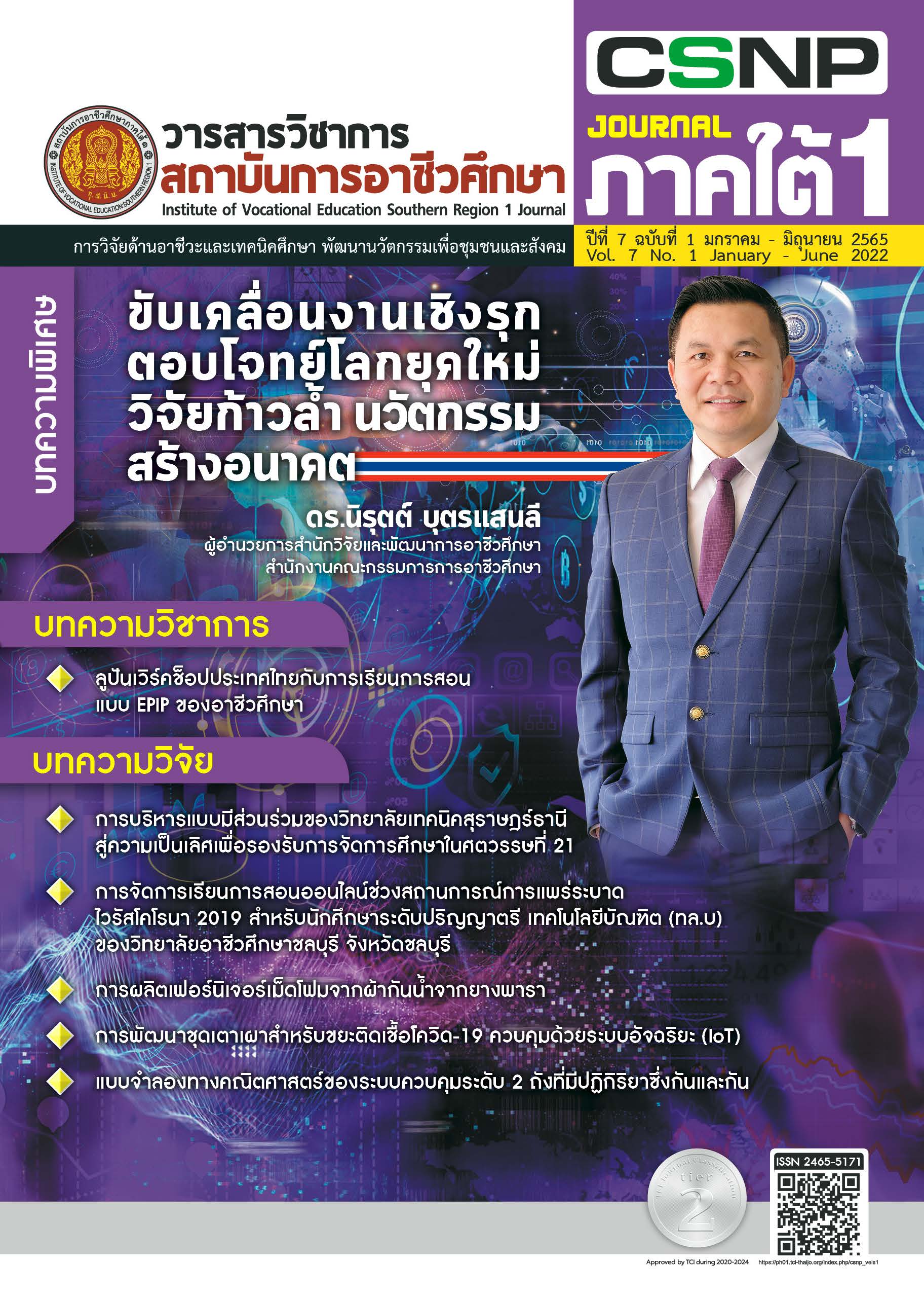Development of Incinerator Sets for COVID-19 Infected Waste Using Intelligent Control (IoT)
Keywords:
Covid-19 Infected Waste, Intelligent Control System, Statistics in Data AnalysisAbstract
The objectives of this research were to: 1) build an intelligently controlled (IoT) incinerator for COVID-19 infected waste; 2) test the efficiency of an incinerator for COVID-19 infected with an intelligently controlled (IoT), and 3) study the results of using the intelligent control system (IoT) prototype. The sample group in this research included 10 staffs of the Solid Waste Management Committee working in Nakhon Si Thammarat Municipality, Nakhon Si Thammarat Province derived by purposive sampling technique. The research tools used to collect data were questionnaires and experimental models. The data were analyzed by frequency, percentage, mean and standard deviation.
The results of the research can be summarized as follows: 1) the results of the construction of an incinerator for COVID-19 infected waste controlled by an intelligent system (IoT) had the highest quality in selecting materials for innovation. 2) The efficiency of an incinerator set for Covid-19 infected waste, controlled by an intelligent system (IoT), has a maximum combustion efficiency of 99.90% and the maximum waste burning rate of 182 kg per hour with an intelligent control system (IoT) that can control the operation of the gas valve. And 3) the percentage of use of the intelligent control system (IoT) that the prototype can actually control the opening of the gas valve.
References
กรรณิการ์ ธรรมพานิชวงค์ และวิชสิณี วิบุลผลประเสริฐ. (2563). ฮาวทูทิ้ง: ทิ้งหน้ากากอนามัยอย่างไร ให้ปลอดภัยกับสังคมและสิ่งแวดล้อม. กรุงเทพมหานคร: กรมอนามัย.
ผู้จัดการออนไลน์. (2563). [ออนไลน์]. หน้ากากอนามัยแบบใช้แล้วทิ้ง อย่าทิ้งมั่ว อาจเป็นขยะติดเชื้อ. [สืบค้นเมื่อวันที่ 3 สิงหาคม 2563]. จาก https://mgronline.com/greeninnovation/detail/9630000035228.
พิชา รักรอด. (2563). [ออนไลน์]. วิกฤตโควิด-19 กำลังซ้ำเติมวิกฤตขยะพลาสติกหรือไม่. [สืบค้นเมื่อวันที่ 3 สิงหาคม 2563]. จาก https://www.greenpeace.org/thailand/story/16270/plastic-single-use-1plastic-crisis-in-covid-9-sitution.
วิเชียร จุ่งรุ่งเรือง สุณี ปิยะพันธุ์พงศ์ สุวิทย์ ขัตติวงศ์ และวชิรา แสงศรี. (2557). กรมควบคุมมลพิษลงพื้นที่ติดตามการแก้ไขปัญหาขยะมูลฝอยนครศรีธรรมราช. วารสารหมายเหตุมลพิษ กรมควบคุมมลพิษ กระทรวงทรัพยากรธรรมชาติและสิ่งแวดล้อม, 11(24), 2-4.
สำนักงานเลขานุการคณะกรรมการบริหารงานจังหวัดแบบบูรณาการจังหวัดนครศรีธรรมราช. (2562). แผนพัฒนาจังหวัดนครศรีธรรมราช (พ.ศ. 2561-2565) ฉบับทบทวน. นครศรีธรรมราช: องค์กรปกครองส่วนท้องถิ่นนครศรีธรรมราช.
กอบเกียรติ สระอุบล. (2561). พัฒนา IoT บนแพลตฟอร์ม Arduino และ Raspberry Pi. กรุงเทพมหานคร: อินเตอร์มีเดีย
นิตยา นักระนาด มิลน์. (2555). เตาเผาขยะชีวมวลไร้ควัน. วารสาร GREEN RESEARCH, 9(21), 6-7.
สถาบันวิจัยสังคม จุฬาลงกรณ์มหาวิทยาลัย. (2558). โครงการติดตามประเมินผลการใช้เตาเผาขยะชีวมวลไร้ควัน. กรุงเทพมหานคร: กรมส่งเสริมคุณภาพสิ่งแวดล้อม กระทรวงทรัพยากรธรรมชาติและสิ่งแวดล้อม.
ธนพร เทพสมุทร และคณะ. (2564). การออกแบบและสร้างเผาผลิตถ่านจากชีวมวลและขยะมูลฝอยระดับชุมชน. วารสารสมาคมวิศวกรรมเกษตรแห่งประเทศไทย, 27(1), 25-31.
สมพร เหล่าดี และพลอยไพลิน โคตรตาแสง. (2563). เตาเผาขยะไร้ควันไร้กลิ่น. โครงการจัดการศึกษาเพื่อพัฒนาคุณภาพชีวิตที่เป็นมิตรกับสิ่งแวดล้อม (1 โรงเรียน 1 นวัตกรรม ประจำปี 2563 ในโรงเรียนคุณภาพประจำตำบล). กาฬสินธุ์: โรงเรียนโคกเครือวิทยา สำนักงานเขตพื้นที่การศึกษาประถมศึกษากาฬสินธุ์ เขต 2.
โสภณวิชญ์ เขียวคำจีน และชัยพร เขมะภาตพันธุ์. (2562). การเปรียบเทียบการพัฒนาโปรแกรมประยุกต์ IoT สำหรับโทรศัพท์มือถือระหว่าง IoT Cloud Platform Application และ End-to-End Application กรณีศึกษาเครื่องให้อาหารปลา. วารสารบัณฑิตศึกษา, 7(3), 946-960.
วริศร์ รัตนนิมิตร วุฒิชัย เกษพานิช และสุทธิลักษณ์ ชุนประวัติ. (2562). การติดตั้งเซิร์ฟเวอร์สําหรับตรวจสอบข้อมูลสมาร์ทฟาร์มผานแอพพลิเคชั่นโทรศัพท์มือถือ. วารสารวิชาการเทคโนโลยีพลังงานและสิ่งแวดล้อม, 6(1), 37-42.
วิวัฒน์ มีสุวรรณ์. (2561). วิจัยทางเทคโนโลยีการศึกษา. พิษณุโลก: สำนักพิมพ์มหาวิทยาลัยนเรศวร.
ณัฐกร สงคราม. (2557). การออกแบบและพัฒนามัลติมีเดียเพื่อการเรียนรู้ (พิมพ์ครั้งที่ 3). กรุงเทพมหานคร: สำนักพิมพ์จุฬาลงกรณ์มหาวิทยาลัย.
English, Lyn D. & King, Donna. (2017). Engineering education with fourth-grade students: Introducing Design-based problem-solving. International Journal of Engineering Education, 33(1), 346-360.
ชโลทร แก่นสันติสุขมงคล. (2563). นวัตกรรม เทคโนโลยี กับการพัฒนาเศรษฐกิจสีเขียว. กรุงเทพมหานคร: คณะเศรษฐศาสตร์ มหาวิทยาลัยธรรมศาสตร์.
Downloads
Published
Issue
Section
License
Copyright (c) 2022 Institute of Vocational Education Southern Region 1 Journal

This work is licensed under a Creative Commons Attribution-NonCommercial-NoDerivatives 4.0 International License.


